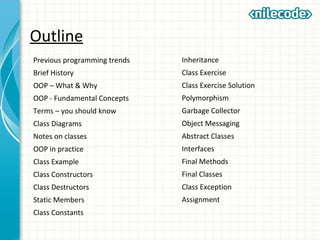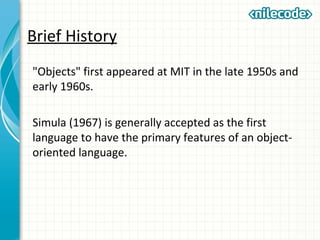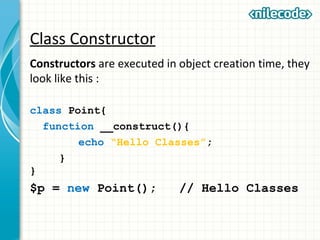Class 7 - PHP Object Oriented Programming
- 2. Outline Previous programming trends Brief History OOP – What & Why OOP - Fundamental Concepts Terms – you should know Class Diagrams Notes on classes OOP in practice Class Example Class Constructors Class Destructors Static Members Class Constants Inheritance Class Exercise Class Exercise Solution Polymorphism Garbage Collector Object Messaging Abstract Classes Interfaces Final Methods Final Classes Class Exception Assignment
- 3. Previous programming trends Procedural languages: splits the program's source code into smaller fragments – Pool programming. Structured languages: require more constraints in the flow and organization of programs - Instead of using global variables, it employs variables that are local to every subroutine. ( Functions )
- 4. Brief History "Objects" first appeared at MIT in the late 1950s and early 1960s. Simula (1967) is generally accepted as the first language to have the primary features of an object- oriented language.
- 5. OOP What & Why? OOP stands for Object Oriented Programming. It arranges codes and data structures into objects. They simply are a collection of fields ( variables ) and functions. OOP is considered one of the greatest inventions in computer programming history.
- 6. OOP What & Why? Why OOP ? •Modularity •Extensibility (sharing code - Polymorphism, Generics, Interfaces) •Reusability ( inheritance ) •Reliability (reduces large problems to smaller, more manageable ones) •Robustness (it is easy to map a real world problem to a solution in OO code) •Scalability (Multi-Tiered apps.) •Maintainability
- 7. OOP - Fundamental Concepts Abstraction - combining multiple smaller operations into a single unit that can be referred to by name. Encapsulation (information hiding) – separating implementation from interfaces. Inheritance - defining objects data types as extensions and/or restrictions of other object data types. Polymorphism - using the same name to invoke different operations on objects of different data types.
- 8. Terms you should know Class - a class is a construct that is used as a template to create objects of that class. This blueprint describes the state and behavior that the objects of the class all share. Instance - One can have an instance of a class; the instance is the actual object created at run-time. Attributes/Properties - that represent its state Operations/Methods - that represent its behaviour
- 9. Terms you should know Below terms are known as “Access Modifiers”: Public – The resource can be accessed from any scope (default). Private – The resource can only be accessed from within the class where it is defined. Protected - The resource can only be accessed from within the class where it is defined and descendants. Final – The resource is accessible from any scope, but can not be overridden in descendants. It only applies to methods and classes. Classes that are declared as final cannot be extended.
- 10. Class Diagrams Class Diagrams ( UML ) is used to describe structure of classes. Person - Name: string + getName(): string + setName(): void # _talk(): string Class Attributes/Properties Class Operations/Methods Class Name Private Public Protected Data type
- 11. Class Diagrams Person - name: string + getName(): string + setName(): void # _talk(): integer class Person{ private $__name; public function __construct(){} public function setName($name){ $this->__name = $name; } public function getName(){ return $this->__name; } protected function _talk(){} }
- 12. Notes on classes • Class names are having the same rules as PHP variables ( they start with character or underscore , etc). • $this is a variable that refers to the current object ( see the previous example). • Class objects are always passed by reference.
- 13. Class Example class Point{ private $x; private $y; public function setPoint($x, $y){ $this->x = $x; $this->y = $y; } public function show(){ echo “x = ” . $this->x . “, y = ”. $this- >y; } } $p = new Point(); $p->setPoint(2,5); $p->show(); // x = 2, y = 5
- 14. Class Constructor Constructors are executed in object creation time, they look like this : class Point{ function __construct(){ echo “Hello Classes”; } } $p = new Point(); // Hello Classes
- 15. Class Destructors Destructors are executed in object destruction time, they look like this : class Point{ function __destruct(){ echo “Good bye”; } } $p = new Point(); // Good Bye
- 16. Static members Declaring class properties or methods as static makes them accessible without needing an object. class Point{ public static $my_static = 'foo'; } echo Point:: $my_static; // foo
- 17. Static members Static functions : class Point{ public static $my_static = 'foo'; public static function doSomthing(){ echo Point::$my_static; // We can use self instead of Point } } echo Point::doSomthing(); // foo
- 18. Class constants Classes can contain constants within their definition. Example: class Point{ const PI = 3.14; } echo Point::PI;
- 19. Inheritance Inheritance is the act of extending the functionality of a class.
- 20. Inheritance(Cont.) Example : Class Employee extends Person { // Check slide #11 private $__salary = 0; function __construct($name, $salary) { $this->setName($name); $this->setSalary($salary); } function setSalary($salary){ $this->__salary = $salary; }
- 21. Inheritance(Cont.) function getSalary(){ return $this->__salary; } } $emp = new Employee(‘Mohammed’, 250); echo ‘Name = ’, $emp->getName(), ‘, Salary = ’, $emp- >getSalary();
- 22. Multiple Inheritance Multiple inheritance can be applied using the following two approaches(Multi-level inheritance by using interfaces) Example : class a { function test() { echo 'a::test called', PHP_EOL; } function func() { echo 'a::func called', PHP_EOL; } }
- 23. Multiple Inheritance(Cont.) class b extends a { function test() { echo 'b::test called', PHP_EOL; } } class c extends b { function test() { parent::test(); } }
- 24. Multiple Inheritance (Cont.) class d extends c { function test() { # Note the call to b as it is not the direct parent. b::test(); } }
- 25. Multiple Inheritance (Cont.) $a = new a(); $b = new b(); $c = new c(); $d = new d(); $a->test(); // Outputs "a::test called" $b->test(); // Outputs "b::test called" $b->func(); // Outputs "a::func called" $c->test(); // Outputs "b::test called" $d->test(); // Outputs "b::test called" ?>
- 26. Class Exercise Create a PHP program that simulates a bank account. The program should contain 2 classes, one is “Person” and other is “BankAccount”.
- 27. Class Exercise Solution class Person{ private $name = “”; public function __construct($name){ $this->name = $name; } public function getName(){ return $this->name; } }
- 28. Class Exercise Solution class BankAccount{ private $person = null; private $amount = 0; public function __construct($person){ $this->person = $person; } public function deposit( $num ){ $this->amount += $num; } public function withdraw( $num ){ $this->amount -= $num; }
- 29. Class Exercise Solution public function getAmount(){ return $this- >amount; } public function printStatement(){ echo ‘Name : ‘, $this- >person->getName() , “, amount = ” , $this- >amount; } } $p = new Person(“Mohamed”); $b = new BankAccount($p); $b->deposit(500); $b->withdraw(100); $b->printStatement(); // Name : Mohamed, amount = 400
- 30. Polymorphism • Polymorphism describes a pattern in object oriented programming in which classes have different functionality while sharing a common interface. Example : class Person { function whoAreYou(){ echo “I am Person”; } }
- 31. Polymorphism class Employee extends Person { function whoAreYou(){ echo ”I am an employee”; } } $e = new Employee(); $e->whoAreYou(); // I am an employee $p = new Person(); $p->whoAreYou(); // I am a person
- 32. Garbage Collector Like Java, C#, PHP employs a garbage collector to automatically clean up resources. Because the programmer is not responsible for allocating and freeing memory (as he is in a language like C++, for example).
- 33. Object Messaging Generalization AKA Inheritance Person Employee
- 34. Object Messaging (Cont.) Association – Object Uses another object FuelCar
- 35. Object Messaging (Cont.) Composition – “is a” relationship, object can not exist without another object. FacultyUniversity
- 36. Object Messaging (Cont.) Aggregation – “has a” relationship, object has another object, but it is not dependent on the other existence. StudentFaculty
- 37. Abstract Classes • It is not allowed to create an instance of a class that has been defined as abstract. • Any class that contains at least one abstract method must also be abstract. • Methods defined as abstract simply declare the method's signature they cannot define the implementation.
- 38. Abstract Classes(Cont.) abstract class AbstractClass{ // Force Extending class to define this method abstract protected function getValue(); abstract protected function myFoo($someParam); // Common method public function printOut() { print $this->getValue() . '<br/>'; } }
- 39. Abstract Classes(Cont.) class MyClass extends AbstractClass{ protected function getValue() { return "MyClass"; } public function myFoo($x){ return $this->getValue(). '->my Foo('.$x. ') Called <br/>'; } } $oMyObject = new MyClass; $oMyObject ->printOut();
- 40. Interfaces • Object interfaces allow you to create code which specifies which methods a class must implement, without having to define how these methods are handled. • All methods declared in an interface must be public, this is the nature of an interface. • A class cannot implement two interfaces that share function names, since it would cause ambiguity.
- 41. Interfaces(Cont.) interface IActionable{ public function insert($data); public function update($id); public function save(); }
- 42. Interfaces(Cont.) Class DataHandler implements IActionable{ public function insert($d){ echo $d, ‘ is inserted’; } public function update($y){/*Apply any logic in here*/} public function save(){ echo ‘Data is saved’; } }
- 43. Final Methods • prevents child classes from overriding a method by prefixing the definition with ‘final’. Example class ParentClass { public function test() { echo " ParentClass::test() calledn"; } final public function moreTesting() { echo "ParentClass ::moreTesting() calledn"; } }
- 44. Final Methods(Cont.) class ChildClass extends ParentClass { public function moreTesting() { echo "ChildClass::moreTesting() calledn"; } } // Results in Fatal error: Cannot override final method ParentClass ::moreTesting()
- 45. Final Classes • If the class itself is being defined final then it cannot be extended. Example final class ParentClass { public function test() { echo "ParentClass::test() calledn"; } final public function moreTesting() { echo "ParentClass ::moreTesting() calledn"; } }
- 46. Final Classes (Cont.) class ChildClass extends ParentClass { } // Results in Fatal error: Class ChildClass may not inherit from final class (ParentClass)
- 47. Class Exception Exceptions are a way to handle errors. Exception = error. This is implemented by creating a class that defines the type of error and this class should extend the parent Exception class like the following : class DivisionByZeroException extends Exception { public function __construct($message, $code){ parent::__construct($message, $code); } } $x = 0; Try{ if( $x == 0 ) throw new DivisionByZeroException(‘division by zero’, 1); else echo 1/$x; }catch(DivisionByZeroException $e){ echo $e->getMessage(); }
- 48. Assignment We have 3 types of people; person, student and teacher. Students and Teachers are Persons. A person has a name. A student has class number and seat number. A Teacher has a number of students whom he/she teaches. Map these relationships into a PHP program that contains all these 3 classes and all the functions that are needed to ( set/get name, set/get seat number, set/get class number, add a new student to a teacher group of students)
- 49. What's Next? • Database Programming.
- 50. Questions?


















































